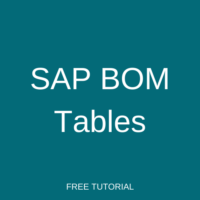 SAP Bill of Material (BOM) is an important master data that belongs to the production and planning module in SAP. There are multiple tables in SAP that store the BOM-related information. Below are the transparent tables belonging to BOM.
SAP Bill of Material (BOM) is an important master data that belongs to the production and planning module in SAP. There are multiple tables in SAP that store the BOM-related information. Below are the transparent tables belonging to BOM.
SAP BOM Tables
| Table | Description |
| STKO | BOM HEADER |
| STPO | BOM ITEM |
| STAS | BOM ITEM SELECTION |
| STPN | BOM FOLLOW-UP CONTROL |
| STPU | BOM SUB-ITEM |
| STZU | PERMANENT BOM DATA |
| PLMZ | ALLOCATION OF BOM – ITEMS TO OPERATIONS |
| MAST | MATERIAL TO BOM LINK |
| KDST | SALES ORDER TO BOM LINK – USED TO VIEW SO BOM DATA |
STKO, STPO, and MAST are the main tables in BOM. Let’s check the key information stored in each of these tables.
STKO Table in SAP BOM
The BOM is divided into two main sections when data is stored. First, we have the header data which is stored in the STKO table. Then, there is the item data which is stored in the STPO table. Key information in the STKO table are:
- BOM Category – This field defines the type of BOM. There can be different BOM types such as material BOM, Order BOM, Equipment BOM, etc.
- Bill of Material Number – This number is used to maintain the relationship between the BOM tables. BOM number to material link is only maintained in the MAST table and the other tables are linked with the material from this BOM number.
- Alternative BOM – If there are alternative BOMs created for a material, the alternative BOM number will be stored in this field.
- Valid From – This is the ‘valid from’ date for the BOM. The BOM will not be exploded in MRP for the days that don’t fall within the validity period.
- Created On – Displays the date on which the BOM was created.
- Created By – Displays the SAP username which was used to create the BOM.
- Base Unit of Measure – The base unit of measure for the material.
- Base Quantity – Represents the base quantity of the BOM. This determines how the component consumptions are entered for each BOM item.
- Created in Plant – The plant where the BOM was created.
STPO Table
Item details of a BOM are stored in the STPO table. Below is the key information stored in the STPO table:
- BOM Category
- Bill of Material Number
- Valid From
- Deletion Indicator
- Item Category
- Item Number
- Component UoM – This is the unit of measurement for the component. If there are alternative units of measures, we can maintain those here.
- Component Quantity – This is the component consumption quantity. Depending on the base quantity, consumptions must be entered.
- Component Scrap % – If there is a scrap percentage maintained in the BOM, it will be stored in this field. This value will be considered during the MRP run.
- Operation Scrap in %
- Production Relevant – If the BOM is production relevant, this indicator will be set.
- Relevancy to Costing – If the BOM is costing relevant, this indicator will be set.
MAST Table
The MAST is a key table in BOM. This table contains the material to the BOM link. The other tables contain the information in relation to the “Bill of Material number”. In the MAST table, the bill of material number is linked to the material code. Below is the key information stored in the MAST table.
- Material – Material code that the BOM represents.
- Plant
- BOM Usage
- Bill of Material
- Alternative BOM
- From Lot Size
- To Lot Size
- Created On
- Created By
—
Did you like this tutorial? Have any questions or comments? We would love to hear your feedback in the comments section below. It’d be a big help for us, and hopefully, it’s something we can address for you in the improvement of our free SAP PP tutorials.
Navigation Links
Go to the next lesson: SAP Safety Stock
Go to the previous lesson: SAP Factory Calendar
Go to overview of the course: SAP PP Training

What is the table name to get sub-assembly components. We can’t get it from STPO & MAST table. Please advise
The main table for BOM explosion data in SAP is typically the STKO table, which contains the header information for the Bill of Materials. The STPO table contains the item details, including components and sub-assemblies.